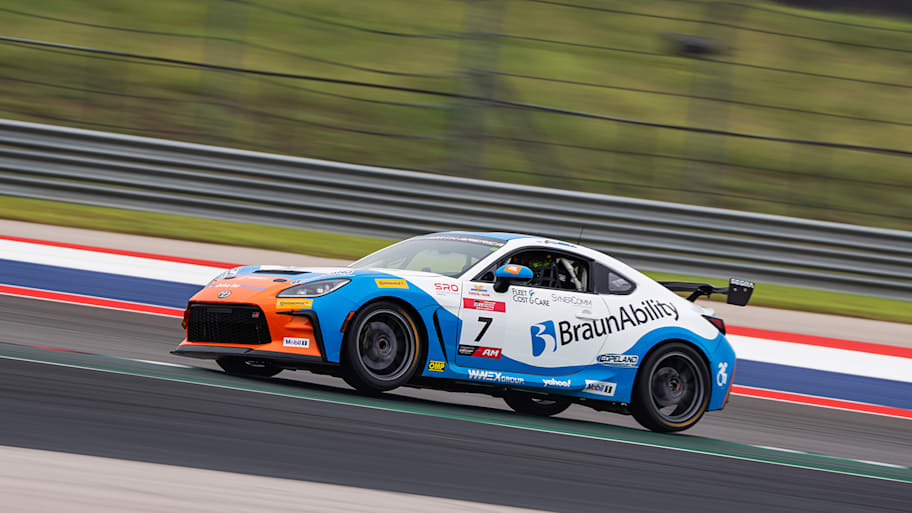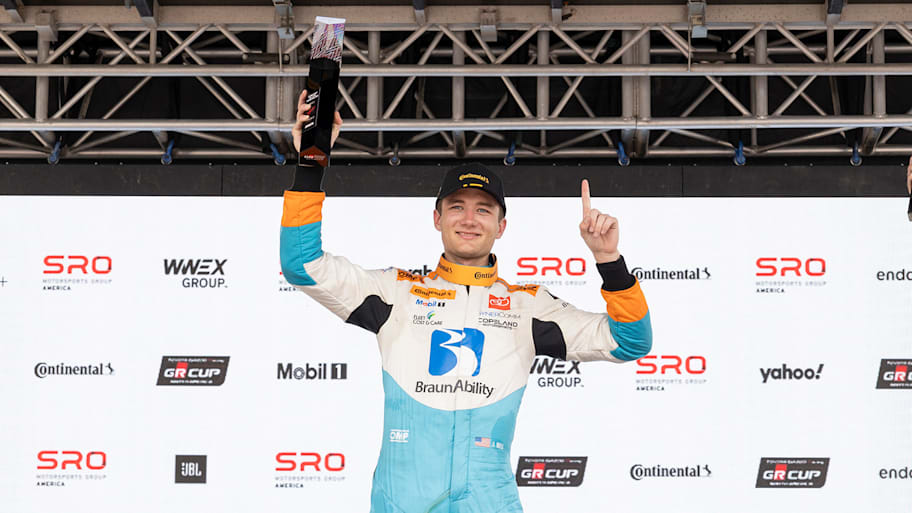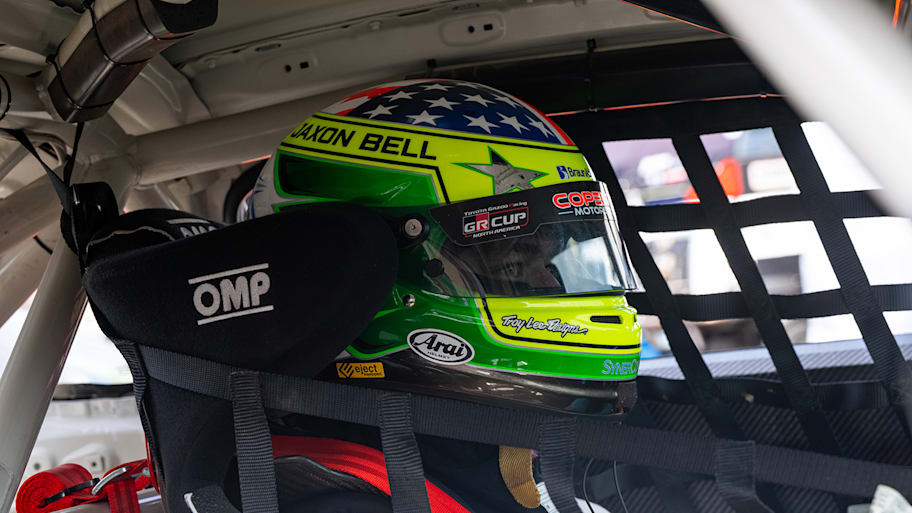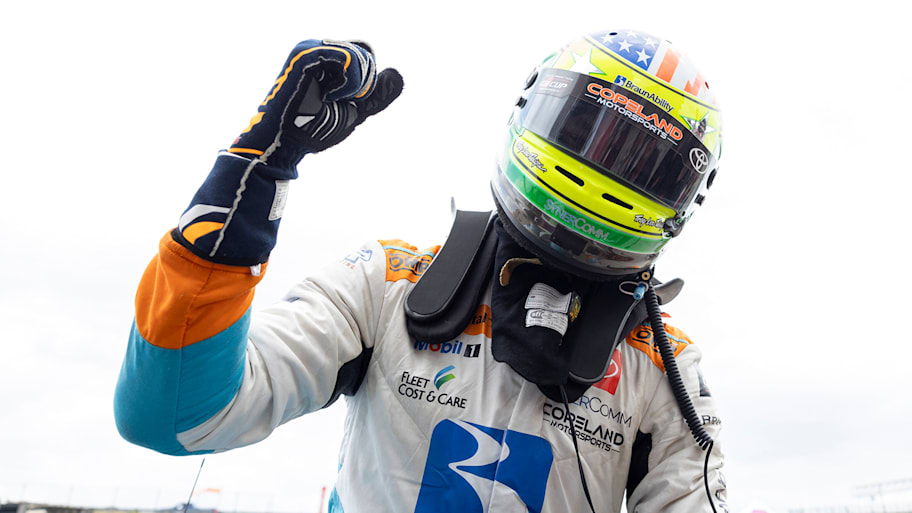Jaxon Bell may be all of 22 years old, but it’s not wrong to think of him as a late bloomer. Even though he didn’t start racing until 2023, he's currently the No. 2 driver in the Toyota GR Cup Series. The kid knows something about fast starts.
The son of former IndyCar driver—and current Fox Sports racing commentator—Townsend Bell, Jaxon grew up in Los Angeles with little practical connection to racing outside of his family’s annual trips to the Indianapolis 500. Most of his time behind the wheel of a race car was accrued on a simulator. But after moving to North Carolina following his high school graduation, Bell landed a job in the shop of a team in NASCAR’s truck series. He learned a little about cars and a lot about racing, and then found his way to a three-day course at the Skip Barber Racing School. A year later, in 2023, he was driving in Barber’s Formula Four Series. He made the jump to GR Cup—which races sports cars—in 2024.
SI: What was your Welcome to Racing Moment?
Jaxon Bell: It might have been like my first year ever racing. I raced in the Skip Barber Formula Four series, and I won the first four races of the season. I was feeling pretty good. I felt like it was gonna be hard beating me, right? And we show up to Virginia for round 3 and I got absolutely waxed by this 14-year-old kid named Sebastian Wheldon. His father, Dan Wheldon, tragically passed away [in 2011] in an IndyCar crash. And his father had raced against my father. And so anyways, I got smoked after winning the first four races, and that was kind of like, Oh, O.K., so this isn't like a cakewalk. This is gonna be a little bit harder than I thought. But in a few years, my claim to fame will probably be that I used to beat Sebastian Wheldon. [Laughs.] Hopefully, he’s going to be in Formula One or IndyCar at some point soon.
SI: When you were growing up, your father was an active IndyCar racer. Did you grow up at the track or did you just go to races?
J.B.: I grew up in Los Angeles, which is pretty far away from wherever an IndyCar race is taking place because there's not much racing in California. So, when my dad was racing, a lot of the time, me and my brother and my mom would be at home. But every year we would go to the Indianapolis 500 and watch them race there because that was the biggest event. And that was kind of a family thing, to go and watch my dad compete. I've been to 15 Indy 500s—I'm going to my 16th this weekend. So, I spent a lot of time watching my dad race and perform at a very high level, and that's kind of where I got my first taste of racing.

SI: You went straight from high school to North Carolina, where you got a job in the NASCAR truck series. How did you make the trip?
J.B.: I didn't really know what I wanted to do after I graduated high school. I’d never raced anything. I had gone to a Skip Barber racing school when I was 12 years old, and I’d been in a few go-karts, but never actually raced competitively. I’d played high school football and baseball, and, as a kid, in Little League. I grew up playing stick-and-ball sports, but I’d always really wanted to go racing. And after I graduated high school, I didn't have any plans. I didn’t want to go to college. I just wanted to be involved in motor sports on some level. And so, my dad was like, Well, North Carolina’s probably the best place to go. That’s kind of the center of racing in the United States. So, I packed up my Volkswagen Golf.... That's how I got there. I was looking for a job and was sleeping on a NASCAR driver’s couch for a little bit, just trying to figure out what I was going to do. And then I finally landed a position as just a shop intern, sweeping floors and cleaning toilets for Shigeaki Hattori, who recently passed away. So that’s how I went from graduating high school to getting my start in motor sports. It was kind of messy and all over the place, but I ended up working for [Hattori’s] NASCAR truck team for a little while.
SI: Which NASCAR driver let you crash on his couch?
J.B.: His name is Myatt Snider. His father, Marty Snider, is an NBC reporter for NASCAR. He’s worked with my dad for many years.
SI: And you knew nothing about cars?
J.B.: You know, I grew up around racing, but my dad’s not really a car guy. Like, he’s really a racer. He doesn’t own any old, classic cars, and he doesn’t have any fancy cars. He kind of just went to the racetrack, drove a car and then came home. We never really spent a lot of time around automobiles. I don’t know—that sounds funny because of my family’s history, but it was very much like go to the racetrack race and come home. I didn't have any experience—I just wanted to be involved.
SI: Was driving always part of the plan? Or did something happen to change your mind?
J.B.: From a very young age I remember always really wanting to get behind the wheel of a race car. I would always have my birthday parties at K1 Speed and the other indoor go-kart tracks, and I just loved it. And my dad made a deal with me: If you meet a certain standard in your academics, I’ll buy you a go-kart and I’ll give you a chance to go racing. And I never committed myself enough to school to meet the standards that my dad had set for me. It made me frustrated and mad that I wasn’t able to do it because I really wanted to, but, looking back on it, I should have just applied myself a little bit more in school. [Laughs.]
Once I graduated I felt kind of like my time was up and I wouldn’t really have an opportunity to drive. So, I just wanted to be involved, and I thought maybe I could make a career out of being a marketing guy or selling sponsorships. My grandfather was in charge of motor sport marketing for a Formula One team at Ford Motorsports back in the 1970s and ’80s. My family had a history of doing that as well. And I just wanted to be involved. I didn’t know in what capacity, but driving wasn’t really in the equation. And then I started working for Hattori and was cleaning parts and doing all the dirty work and realized that, you know, This is not what I want to do for the rest of my life. And so, if I have a little bit of time left, I want to give it a shot and try and go racing. I was able to get to a Skip Barber Racing School, and I was faster than my dad, actually, after he jumped in the same car as me. And that was kind of like the spark. Maybe I can do this, and maybe I’m not out of time.

SI: Did you have experience on simulators or video games?
J.B.: I spent a lot of time on racing simulators as a kid. Because I didn’t have the opportunity to race go-karts I bought myself a little steering wheel and pedals and convinced my parents to get me a membership for iRacing, which is the online software that everyone uses. One of my first ever jobs was actually being a “test driver” for a simulator company based in Los Angeles when I was probably 12 or 13 years old. I’ve been in and around simulators my whole life, and that’s really what I attribute my quick success to, because I never did go-karting or raced quarter midgets or anything like that—most of the guys I’m racing against did. And I really think that the simulators that I drove as a little kid really helped bridge the gap to some of the guys that have been doing it for a long time.
SI: It gave you confidence?
J.B.: Yeah. A lot of it is what you’re able to translate from the simulator to the real thing. Like every track that I had never been to before, I’d actually been to on the simulator. So I knew where I was going, right? It didn’t feel completely foreign. It’s still a completely different thing. And I think you have to have some natural gift or ability once you get in a real car to really make it work. But the simulator was an incredible tool for me to use to just get comfortable and familiar with what I could eventually expect in the real race car.
SI: The Skip Barber series you mentioned earlier, it’s a pretty intense training ground. But everyone in that series is still learning as well. What was the competition like?
J.B.: It was a really funny mix of drivers. Like, we would have Sebastian Wheldon and myself, and then we would also have, you know, a 65-year-old guy who was just doing it for fun. Like his kids had bought it for him or something, and he’s just out there having a good time, right? So, it was cool. But everyone is there as the first step in their careers. It was fun to learn and develop at that early stage with all these different people. But certainly the track record of the school speaks for itself, with, you know, Josef Newgarden, Colton Herta—all the guys at the top of our sport today. That’s where they all started. So, that’s why I went there, and that’s why all these people are successful that come out of there.
SI: Why did you make the jump from open-wheel to sports cars in the GR Cup series?
J.B.: My background is in open-wheel stuff. And my dream was, and still is, loosely, to run the Indianapolis 500 at some point in my life. But once I finished the Skip Barber Racing Series, I kind of looked at all my options, and the best place for me to go to progress and hopefully turn this into a career where I’m getting paid as a professional driver, was to get into sports cars—especially with a manufacturer like Toyota, where they have a big presence in the sport, and they have a development ladder, and they have a path to where you want to go.
SI: What’s the competition like in GR Cup?
J.B.: It’s a lot more competitive than Skip Barber. For one, it has a lot more cars. At each GR Cup race, there are about 30 to 35 cars that show up. And everyone’s there to try to make an impression on Toyota, as well as on other teams in the sports car world. So everyone’s fighting tooth and nail. It’s highly competitive, and people who have been successful in GR Cup have gone on to be really successful at higher levels in the sports car world. But it's also cool that we have the opportunity to race against Keanu Reeves and all these other celebrity guests. It’s really a great series, and it’s the perfect place to kind of take the next step and really enter the professional realm of motor sports.

SI: Do you have a favorite track? Is it the Brickyard?
J.B.: Yeah, my favorite track is the Brickyard—the oval, not the road course, which I’ve never raced on—just because of the history of the track and my family history at that track. Like I said, I’m going to my 16th 500 [this] weekend and it still feels like the first time, right? I’m just so excited.
My favorite track in GR Cup is probably Road America. I just love where it's located, in the wilderness of upstate Wisconsin. And it’s the fastest track on the schedule. It’s super high speed. My favorite corner on the track is the Kink, which is high-commitment, flat-out.
SI: Does your dad get out to see you race?
J.B.: Yeah, he comes to as many races as he can. He’s super busy with the IndyCar stuff. He’s the commentator on Fox for Indy car, so he's super busy and oftentimes there are some conflicts between his schedule and mine, but any race he can come to, he’s usually there. And, you know, the only way that we make this whole program work is with our partners and with our sponsors, and he helps kind of manage those sponsored guests and partners that come to the racetrack. My mom does the same. She’s great about helping us put all these opportunities together, and then helps maintain them once I get to the racetrack. And of course, they're also there to support me. I couldn’t do it without them.
SI: By the way, did you get to meet Keanu when you raced against him in Indianapolis last October?
J.B.: I did. He was a supercool guy, very nice. I actually had a funny moment with him on-track, where I was coming around him in one of the sessions and he had this massive drift in front of me. And I thought he was 100% going to hit the wall and come back on the track and take me out with him. But he saved it and didn’t hit the wall, and I was super impressed and went up to him afterwards and was just, you know, giving him props for saving his race car and probably mine, too, which was funny. He’s a really nice guy.
This article was originally published on www.si.com as Jaxon Bell Has His Sights Set on the Toyota GR Cup Series Title .
